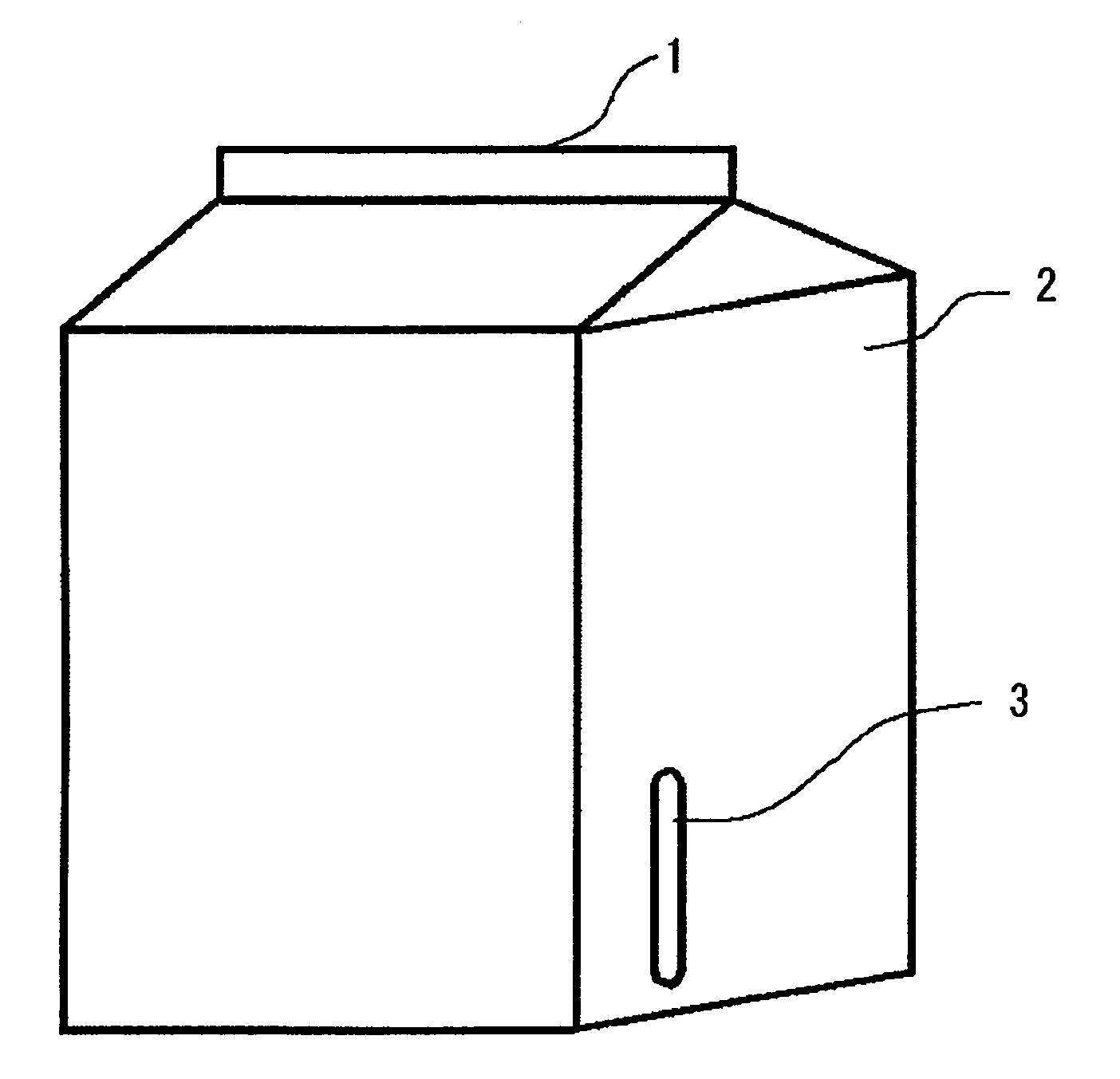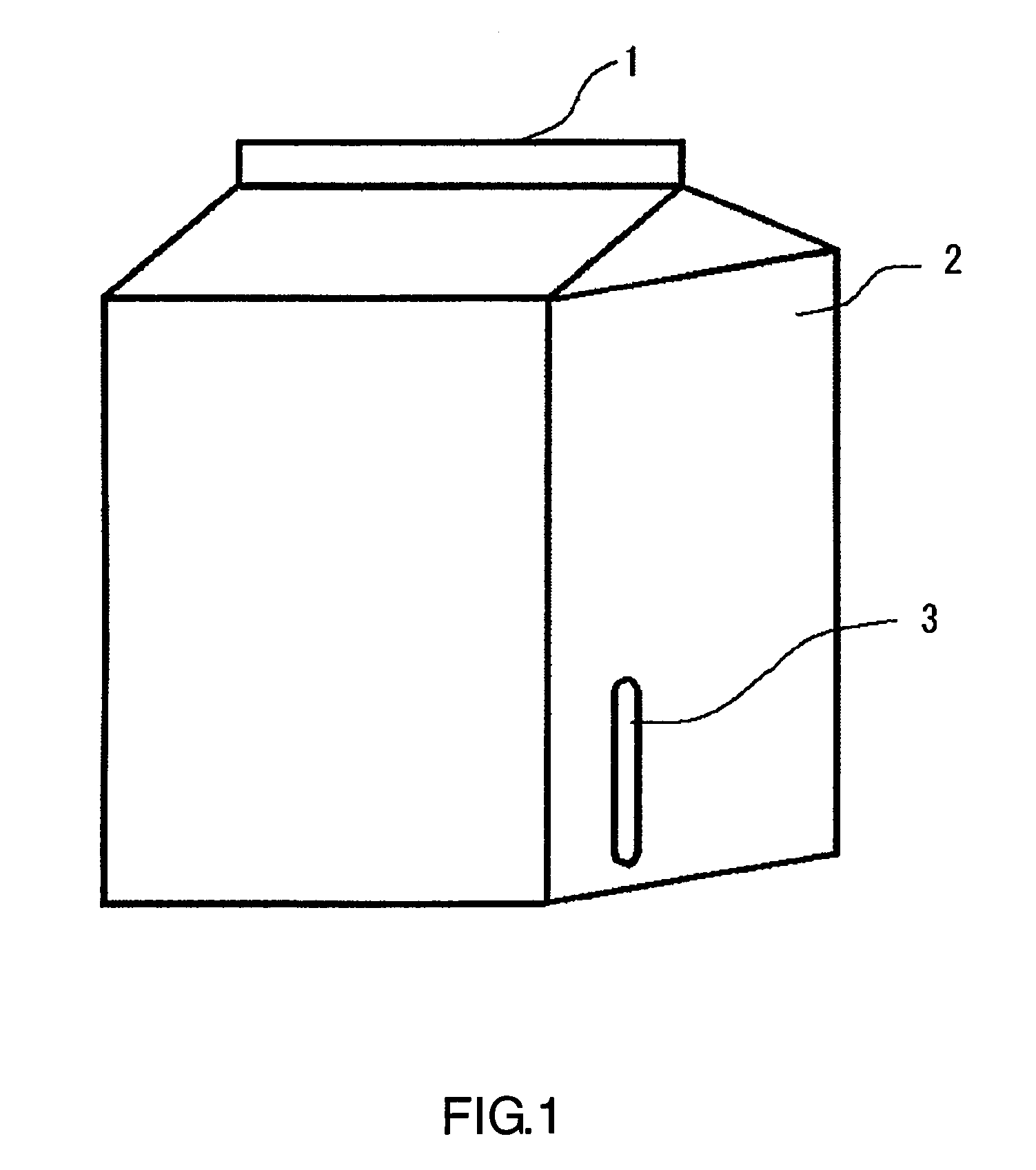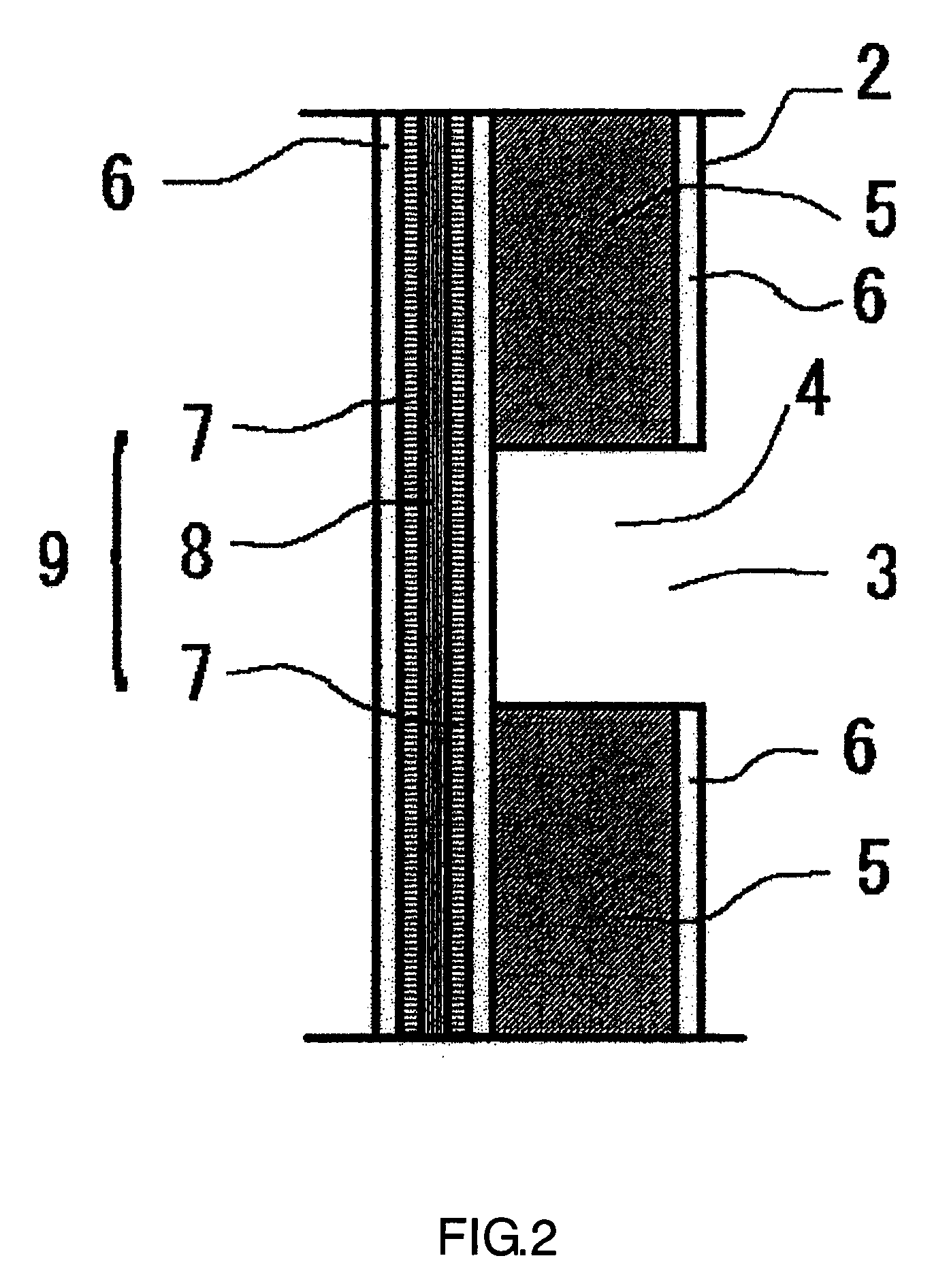Recently, however, with an increase in applications of paper containers where increasingly higher barrier properties are required, sufficiently high gas barrier properties for such applications cannot be obtained by films of, for example,
polyvinyl alcohol and a saponified
ethylene-
vinyl acetate copolymer, or films formed by
coating, for example,
polyethylene terephthalate,
polyamide,
polyvinyl alcohol, or a saponified
ethylene-
vinyl acetate copolymer with
polyvinylidene chloride.
In the films obtained by vapor depositing an inorganic material such as
silicon oxide or aluminum
oxide on, for example,
polyethylene terephthalate,
polyamide,
polyvinyl alcohol, or a saponified
ethylene-
vinyl acetate copolymer, since the inorganic material layer lacks in flexibility, defects tend to be caused when they are subjected to bending or
impact and the gas barrier properties may be deteriorated during the production or transportation of the containers.
Accordingly, they are not satisfactory in terms of productivity, and they also lack in reliability as containers.
Furthermore, in the case of using aluminum, there is a problem in that when the paper container is disposed by, for example,
incineration, aluminum remains and therefore it is not suitable in terms of disposal.
Furthermore, there also is a
disadvantage in that the contents cannot be warmed with a
microwave oven in the case of a product including food packaged in a paper container in which
metal such as aluminum is used.
As described above, currently there are no paper containers that can be subjected to a
retort process, that have a high forming processability, and that have sufficiently high gas barrier properties in various shapes.
Therefore the phenomenon that heat transfers through the aluminum portion of a laminate film, i.e. so-called “heat bridge” occurs and thereby the heat insulation performance is deteriorated.
However, pinholes tend to be formed in deposited
layers obtained by the vapor deposition method, and defects such as pinholes tend to occur in deposited
layers in producing laminate films or transporting the products.
As a result, the gas barrier properties are poor and are not exhibited stably, and thereby there is a problem in reliability.
However, the gas barrier properties thereof are still not sufficiently high and the heat insulating effect cannot be maintained satisfactorily over a long period of time.
However, glass containers have problems in that, for instance, they tend to be damaged by
impact, are heavy, tend to generate glass flakes, and generate insoluble fine particles.
The
polyolefin resin cannot be considered to have sufficiently high gas barrier properties and has a problem in that infusion solutions such as
amino acid preparations, glucose preparations,
fat emulsion preparations, or
electrolyte solutions, with which the infusion bags are filled, tend to be deteriorated by gas such as
oxygen.
As described above, there is a problem in that the
polyolefin resin has poor gas barrier properties.
However, in the method in which a separate outer packaging material is used, once the outer packaging material is opened, for example, for mixing a
drug solution thereinto,
air tightness is lost.
However, such
polyamide resin does not have sufficiently high barrier properties for applications that require a high degree of gas barrier properties and tends to have degraded barrier properties when being subjected to high temperature
steam sterilization.
However, the barrier layer described therein, for example, deposited
alumina or silica, has poor flexibility.
Accordingly, there are concerns that the bag is damaged during transportation or handling thereof and the barrier properties are degraded.
Furthermore, when EVOH, PVA, or PVDC is subjected to high temperature
steam sterilization, barrier properties thereof are degraded.
Moreover, since PVDC contains
chlorine, care needs to be taken during disposal and
incineration thereof.
However, when it is disposed as waste after being used as a cover member, there is a problem in that, for example, it causes poisonous gas such as dioxin to be generated upon
incineration and therefore the environmental suitability is impaired.
However, there is a problem in that when the EVOH film absorbs
moisture, the
oxygen barrier properties thereof are degraded.
Moreover, when a deposited film is used, there is a problem in reliability to gas barrier properties, that is, an inorganic deposited layer that serves as a gas barrier layer tends to crack and have degraded gas barrier properties.
Gas barrier properties may be degraded due to, for example, cracks caused in a printing process or a lamination process through which a multilayer laminate is produced with a deposited film and another film, or cracks caused in a gas barrier layer due to vibrations during transportation when a number of containers with a cover are to be transported, with respective containers with a cover being stacked together.
However, since the laminate material cannot be made transparent, the design of packaging materials is limited.
Furthermore, since it is difficult to see the contents through it, it is not easy to check, for example, deterioration or remaining amount of the contents and further it was inconvenient for squeezing all the contents out thereof.
Moreover, when the tube containers are used as packaging containers and thereafter are disposed as waste, since aluminum remains, they lack disposability and remaining aluminum damages incinerators, which are problems.
However, the transparent deposited films tend to have defects such as cracks caused in a deposited layer that serves as a gas barrier layer in the processes for manufacturing a laminate tube container, for example, a printing process and a lamination process.
Furthermore, when the laminate tube containers are squeezed, defects such as cracks also tend to be caused.
As a result, the transparent deposited film has poor gas barrier properties.
The film formed using
polyvinylidene chloride resin has a problem from an environmental viewpoint because when the laminate tube container is used as a packaging container and is then incinerated as waste, harmful gas such as dioxin may be generated.
However, the ethylene-
vinyl alcohol copolymer has a problem in that when it absorbs
moisture, the gas barrier properties thereof are degraded.
However, all the laminates have the problems described below and are not satisfactory as materials for vacuum packaging.
That is, the laminate including an
aluminum foil layer is not transparent and therefore does not allow the state of contents to be checked or does not allow a metal
detector to be used for inspection of the contents.
However, cracks and pinholes are generated in the deposited layer due to deformation of the packaging material that occurs during vacuum packaging and thereby the gas barrier properties thereof are degraded.
In other words, defects such as cracks and pinholes are caused in the deposited layer due to deformation of the packaging material that occurs according to the contour of contents, or due to bending at the boundary between a heat sealed portion and a portion that comes into contact with the contents.
Furthermore, it also has problems in that cracks and pinholes are caused in the deposited layer to degrade the gas barrier properties thereof due to expansion and contraction caused during heat sterilization
processing as well as shock and bending caused during handling the packaged products.
However, the improvement effect thereof is not satisfactory and the use thereof as a vacuum packaging bag is limited at present.
A laminate including, as a gas barrier layer, a saponified ethylene-vinyl acetate copolymer (EVOH) layer is excellent in gas barrier properties but has a problem in that the gas barrier properties are degraded by the heat
sterilization process following the vacuum packaging.
Vacuum packaging carried out as described above prolongs
shelf life of the contents, foodstuffs.
However, if the contents are foodstuffs containing solids, the packaging bag is deformed according to the contours of the foodstuffs and also is bent at the boundary between the heat sealed portion and a portion that is in contact with the foodstuffs, and thereby the gas barrier properties are degraded, which results in shorter
shelf life of the foodstuffs.
At present, there are still no packaging bags that have solved the problems concerning the environment and safety that have been highlighted recently and have solved the aforementioned problems accompanying the vacuum packaging.
However, such containers result in high packaging material cost and have poor disposability because the packaging materials cannot be reduced in volume at the time of disposal.
However, the polyamide resin as described above does not have sufficiently high barrier properties for applications that require a high degree of gas barrier properties and tend to have degraded barrier properties when being subjected to a retort sterilization process.
Furthermore, there is a problem in that for example, vinylidene
chloride or
polyacrylonitrile may become a source of harmful substance at the time of disposal and incineration.
Although metal foils are excellent in gas barrier properties, they have problems in that they do not allow contents to be seen through the packaging material to be checked, they do not allow a metal
detector to be used for inspection, and they are environmentally undesirable because it is difficult to separate a metal layer from other
layers for disposal after use and therefore they have to be treated as an incombustible.
However, when these films are bent or impacted accidentally during packaging the contents or distribution, the spout-attached part or heat sealed portion of the spout pouch body, especially an edge portion thereof, may be damaged and the
inorganic oxide deposited layer may be cracked, which causes degradations in gas barrier properties and steam barrier properties.
Furthermore, similarly in the case where, for instance, retort cooking sterilization carried out after packaging of the contents causes the inner pressure to increase, the
inorganic oxide deposited layer also may be cracked in the vicinity of the portion sealed to form a bag.
However, due to its flexibility, a packaging bag formed of a film laminate cannot be prevented from being bent during packaging of the contents or distribution, or cannot prevent tension from occurring due to change in inner pressure during sterilization cooking.
Thus there are disadvantages that damage occurs at the spout-attached part or heat sealed portion of the spout pouch body, especially an edge portion thereof, which results in degradation in gas barrier properties of the container.
 Login to View More
Login to View More 


